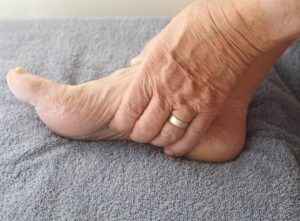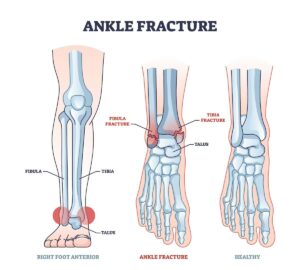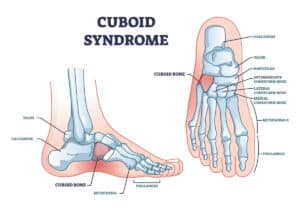Free download: Top 10 Natural & Easy Remedies for Joint Pain from Home. Learn these helpful remedies.
Ankle impingement syndrome occurs when ankle motion becomes limited and painful. This can occur either in the front (anterior) portion of the ankle joint or in the back (posterior) portion of the ankle joint.
What exactly causes this impingement of the ankle?
Can it be corrected?
Let’s take a closer look at the causes behind this condition and top strategies to fix it.
Table of Contents
What Causes Ankle Impingement?
This syndrome is thought to be caused by trauma, repetitive overuse, or an anatomical cause. Impingement of the ankle can be a soft tissue impingement or a bony impingement, such as from bone spurs.
Trauma
Potential ankle joint traumas that may increase risk of impingement include the following:
- Repeated ankle sprains
- Ankle bone fracture
- Tearing of any soft tissue structures, such as the Achilles tendon or peroneal tendon
Repetitive Overuse
Overuse injuries that can increase chances of developing ankle impingement syndrome are typically experienced by athletes.
Football players, soccer players, gymnasts and ballet dancers are a few examples of athletes who are at a higher risk for developing this issue.
Repeated motions of ankle dorsiflexion and plantar flexion, especially in a loaded or weight bearing position, increase the chances of ankle impingement.
Anatomical Causes
Bony abnormalities are the most common anatomical cause behind ankle impingement.
Development of bone spurs or osteophytes in the ankle joint can impinge upon surrounding soft tissues, creating a smaller space in the joint. Trying to move the ankle with this occurring, leads to the impingement.
Degenerative changes in the ankle joint can also affect the joint space and lead to impingement, similar to the presence of bony spurs.
Types of Ankle Impingement

Ankle impingement syndrome has different classifications based on the exact location where the impingement is occurring in the ankle joint.
1. Anterior Ankle Impingement
Anterior ankle impingement is also known as footballer’s ankle.
While the name footballer’s ankle may lead you to think that only football players experience anterior ankle impingement, this anterior impingement can occur in various types of sports.
Other sports, besides football, that may experience anterior ankle impingement include soccer, dancers, basketball and gymnasts.
Anterior ankle impingement can be caused by repetitive plantar flexion, but more commonly is from repetitive dorsiflexion.
This repetition can lead to inflammation and development of scar tissue in the ankle joint. This repetitive strain can cause the development of bone spurs as well.
Symptoms
Symptoms of anterior ankle impingement syndrome will include one or more of the following:
- Decreased ankle joint range of motion, particularly dorsiflexion
- Ankle pain flexing the foot up or into dorsiflexion
- Ongoing anterior ankle pain and tenderness
- Soft tissue edema or swelling
2. Anterolateral Ankle Impingement
There is a space located on the anterolateral ankle (front of the ankle and slightly to the outside) called the anterolateral gutter.
When this space becomes compressed from soft tissue impingement or bony structural impingement, then pain will occur. The smaller space in the joint capsule will create anterolateral ankle impingement.
Previous or recurrent sprain of the outer ankle anterior talofibular ligament (ATFL) is one of the most common causes of anterolateral ankle impingement.
This ligament is most commonly injured via an inversion ankle sprain, where excessive ankle plantar flexion and inversion occurs forcefully. Subsequent ankle instability after recurrent inversion sprains will contribute to impingement onset.
Symptoms
Symptoms of anterolateral ankle impingement will include one or more of the following:
- Decreased ankle range of motion, particularly dorsiflexion and eversion or outward rotation
- Anterior or anterolateral tenderness of the ankle
- Anterolateral ankle swelling
3. Anteromedial Ankle Impingement
The space located to the front and inside of the ankle joint is called the anteromedial recess.
Repetitive ankle dorsiflexion and inversion are common motions to reduce space in this region and can contribute to anteromedial ankle impingement syndrome. This is common in running sports, such as cross country and soccer.
A previous plantar flexion and inversion sprain of the ankle can also be a predisposing factor for anteromedial ankle impingement syndrome.
Symptoms
Symptoms of anteromedial ankle impingement will include one or more of the following:
- Decreased ankle range of motion and pain with repetitive dorsiflexion and inversion
- Anteromedial ankle swelling
- Tenderness over the front and inside of the ankle
4. Posterior Ankle Impingement
Posterior ankle impingement occurs when the structures in the posterior, or back, of the ankle joint become compressed.
Posterior impingement syndrome is most common in sports that require repetitive ankle plantar flexion, such as dance, gymnastics and soccer. Besides an overuse plantar flexion injury, it’s also possible that a forced ankle plantar flexion moment can create posterior ankle impingement.
It’s additionally important to note that bone spurs or osteophyte development in the posterior ankle can lead to bony posterior ankle impingement.
Sometimes other issues can develop as a result of the posterior ankle impingement, such as tendonitis or tenosynovitis of compressed soft tissues. The muscle-tendon unit of flexor hallucis longus is an example of this.
Symptoms
Posterior impingement signs and symptoms may include one or more of the following:
- Ankle pain when flexing the foot down, or plantar flexion
- Decreased ankle range of motion, especially with plantar flexion
- Tenderness in the back or posterior aspect of the ankle
- Posterior ankle swelling
5. Posteromedial Ankle Impingement
Just like the location of the possible anterior impingement syndromes, there exists a posteromedial recess.
The most common injury that can causes posteromedial ankle impingement is a forced position of ankle plantar flexion, inversion and internal rotation. This can cause trauma and impingement around the posterior tibiotalar ligament (PTTL), posterior tibialis tendon, flexor hallucis longus or flexor digitorum longus tendons.
Symptoms
Common symptoms related to posteromedial ankle impingement include one or more of the following:
- Pain and decreased range of motion primarily with ankle plantar flexion and inversion
- Swelling over the posteromedial portion of the ankle
- Tenderness over the posteromedial portion of the ankle
6. Extra Articular Lateral Hindfoot Impingement Syndrome
Extra articular lateral hindfoot impingement of the ankle is commonly related to some type of posterior tibialis tendon injury. This injury can lead to abnormal foot and ankle positioning, such as a flat foot and valgus of the hindfoot.
The exact structures causing the impingement can vary on the lateral, or outside, aspect of the ankle.
It’s also possible to consider the presence of a flat foot and hindfoot valgus without posterior tibialis tendon injury. There could be a natural structural deformity of the foot and ankle causing this, and creating the lateral hindfoot impingement of the ankle.
The two most common areas of lateral hindfoot impingement syndrome include talocalcaneal impingement (impingement of the outer or lateral talus and heel or calcaneus) and subfibular impingement (impingement of heel or calcaneus and the fibula).
Symptoms
The following symptoms may be associated with lateral hindfoot impingement:
- Pain and tenderness on the outside of the hind foot
- Decreased ankle range of motion, particularly with ankle plantar flexion and eversion
- Tenderness of the lateral aspect of the hindfoot
How to Test for Ankle Impingement

Now that we know more about all of the different types of ankle impingement syndromes, let’s take a look at how to test and confirm an actual diagnosis.
Physical Examination
When there is suspicion of ankle impingement syndrome, your doctor will perform an in-depth exam to confirm this and rule out other possible diagnoses.
The physical exam will involve testing your foot and ankle range of motion, strength, assessing structural and postural alignment, and attempting to reproduce your symptoms.
It’s important to rule out all other possible reasons as to why your foot and ankle is having pain. Examples of other diagnoses that may try to mimic this condition include the following:
- Foot or ankle stress fracture
- Peroneal tendon subluxation
- Tendon tear or rupture, such as of the posterior tibialis or Achilles tendon
- Ligament ruptures, such as the deltoid ligament
- Sinus tarsi syndrome
Imaging
Imaging can be a valuable tool to confirm a diagnosis of ankle impingement, and rule out other possible causes of pain.
X-rays are best to assess the status of the bony structures. It will help to determine if there are bone spurs, osteophytes, an abnormal structural alignment of the joints in the foot and ankle, and to rule out a more serious injury, such as a fracture.
CT scans and magnetic resonance imaging (MRI) are better for observation and assessment of potential soft tissue impingement lesions. They will also be able to better assess other potential soft tissue injuries, such as tendon, ligament and muscle ruptures or tears.
Rest to Treat Ankle Impingement
First and foremost when treating this issue, similar to any region with an acute injury, try to rest the area.
If you have been dealing with chronic ankle pain related to an acute flare up of ankle impingement, similarly, try to rest the area at first.
If you are experiencing ankle pain when walking, you may want to try to limit your walking activities initially to help control pain. Do make sure to stay as mobile as you can for your day-to-day activities, but avoid overuse of the injured area.
Physical Therapy and Exercise for Ankle Impingement
It’s not uncommon for your doctor to refer you to physical therapy to address your pain and limitations.
Physical therapy will incorporate various treatment measures, including exercises.
Ankle impingement exercises will key in on any flexibility and/or strength limitations, especially if any muscle imbalances are present.
The following exercises are common to incorporate with this diagnosis, although the exact exercises prescribed will vary depending if your impingement falls into the category of anterior ankle impingement syndromes or posterior ankle impingement syndromes.
Four-Way Ankle Stretch for Ankle Impingement
A four-way ankle stretch helps to move the ankle joint in its four primary directions: ankle dorsiflexion, plantar flexion, inversion, and eversion.
You will manually stretch the foot and ankle in each of these directions, while sitting with the injured ankle crossed over and resting on the opposite thigh.
1. Ankle Dorsiflexion
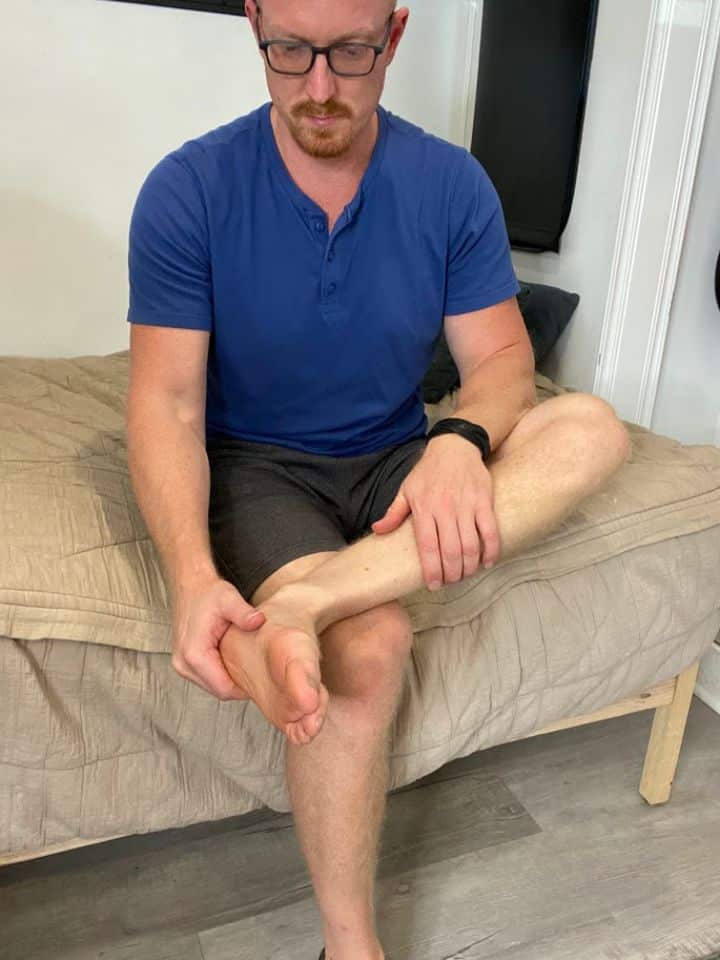
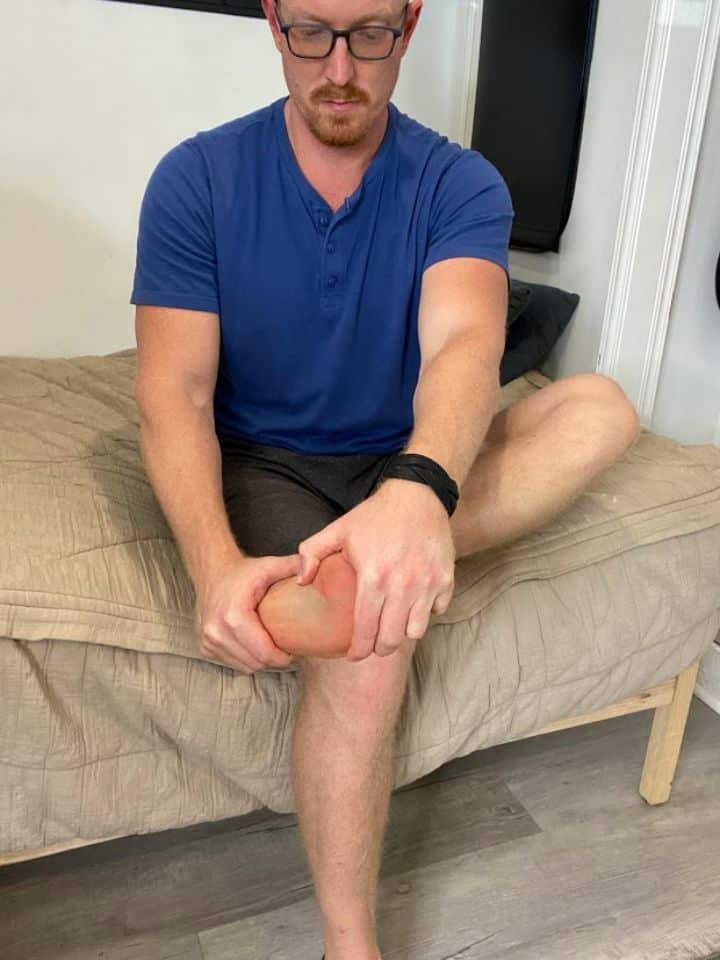
- Place one hand on the bottom of the foot, positioned over the ball of foot.
- Gently, pull the foot back into dorsiflexion until a gentle stretch is felt on the back side of the heel and ankle.
- If the stretch is very intense at first, try holding for 5 seconds, then rest. Repeat 10x.
- If the stretch is only mild, then try a longer hold time anywhere from 30-60 seconds.
This stretch is particularly useful for posterior ankle impingement syndrome symptoms.
2. Ankle Plantar Flexion
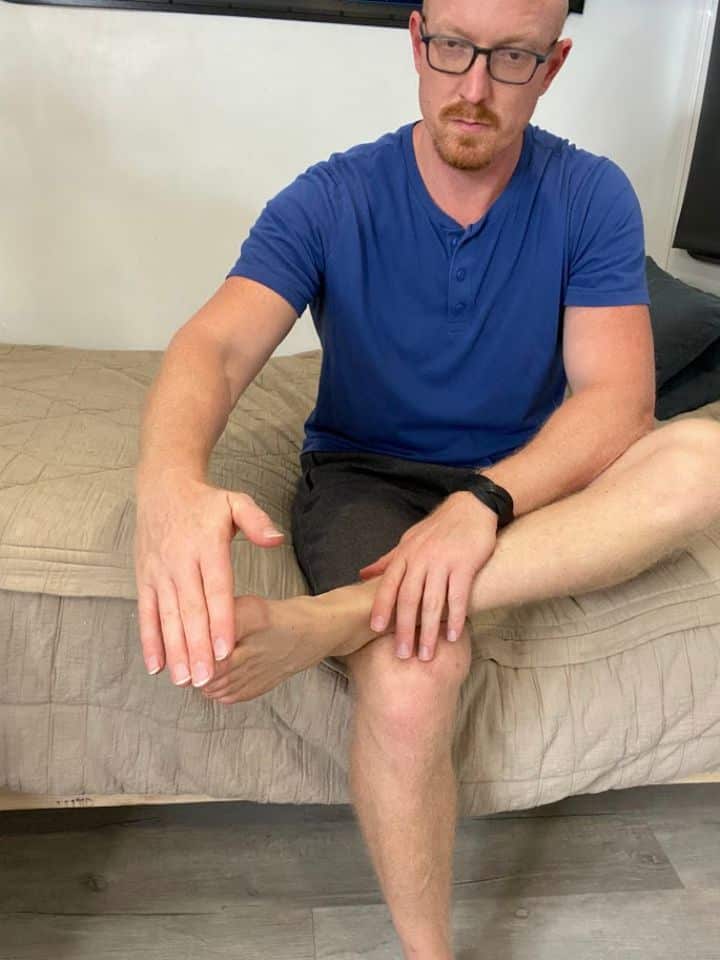
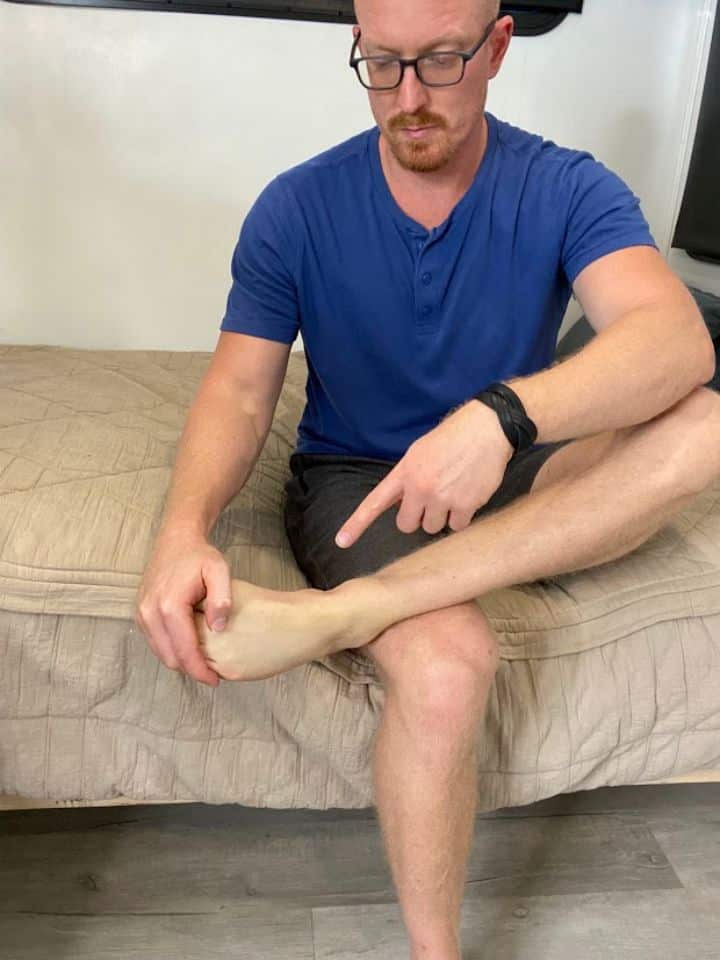
- Place one hand on the top of the foot, positioned on the forefoot near the toes.
- Gently, pull the foot down into plantar flexion until a gentle stretch is felt on the front side of the foot and ankle.
- If the stretch is very intense at first, try holding for 5 seconds, then rest. Repeat 10x.
- If the stretch is only mild, then try a longer hold time anywhere from 30-60 seconds.
This is a particularly useful anterior ankle impingement exercise.
3. Ankle Inversion
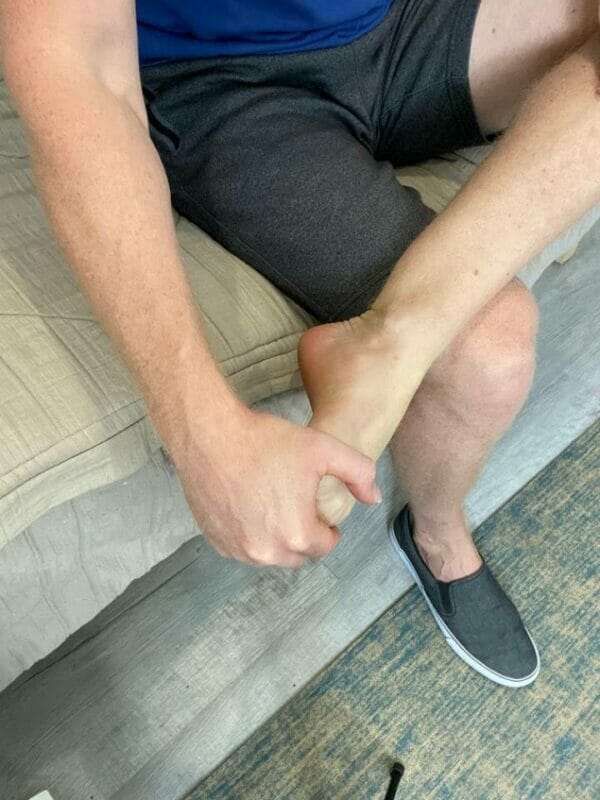
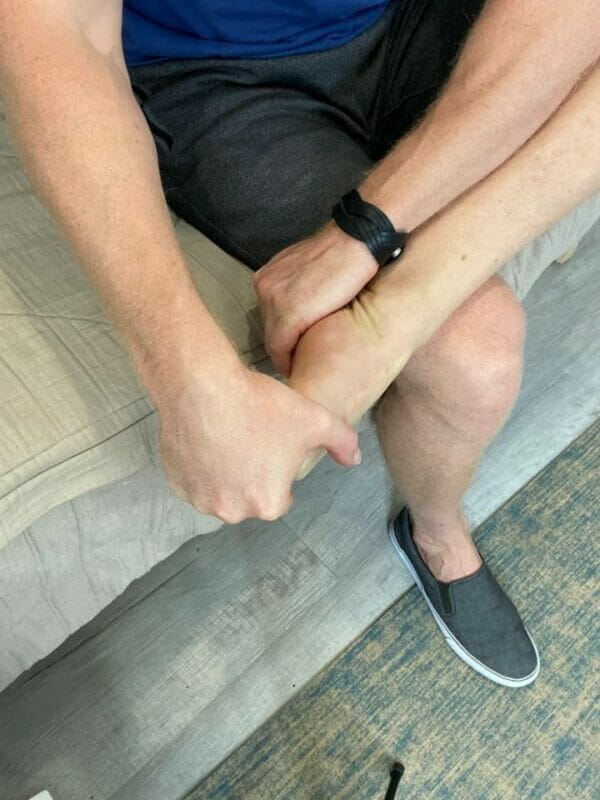
- Place one hand on the top of the foot, positioned on the forefoot near the toes.
- Gently pull the foot and ankle into a plantar flexion stretch, then pull slightly inward so that the foot is pulled towards you.
- If the stretch is very intense at first, try holding for 5 seconds, then rest. Repeat 10x.
- If the stretch is only mild, then try a longer hold time anywhere from 30-60 seconds.
This is a good stretch particularly for anterolateral impingement syndrome symptoms.
4. Ankle Eversion
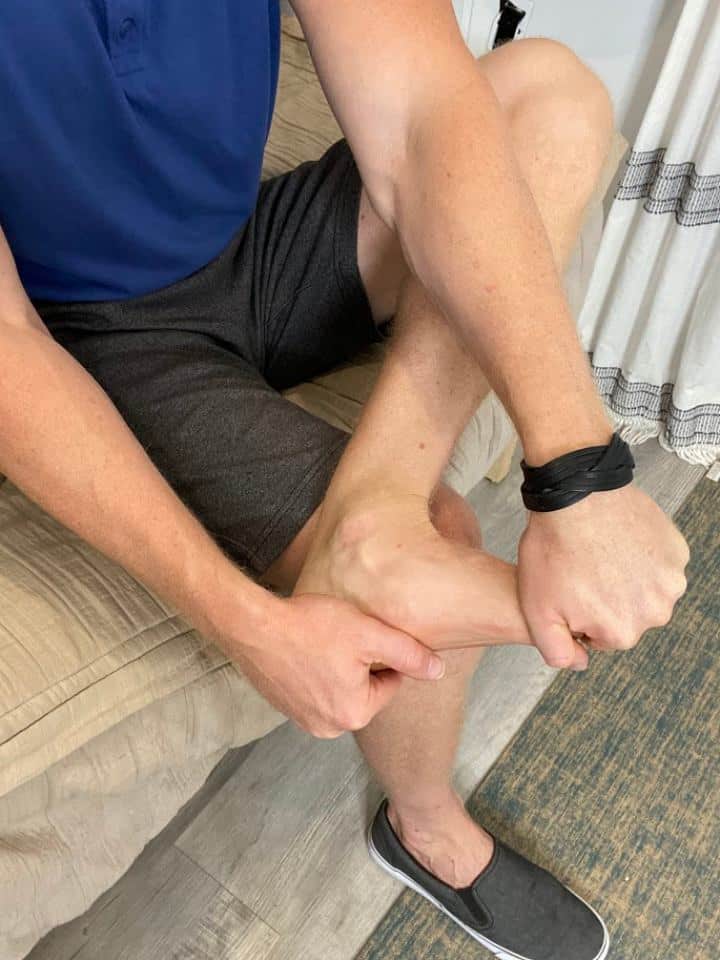
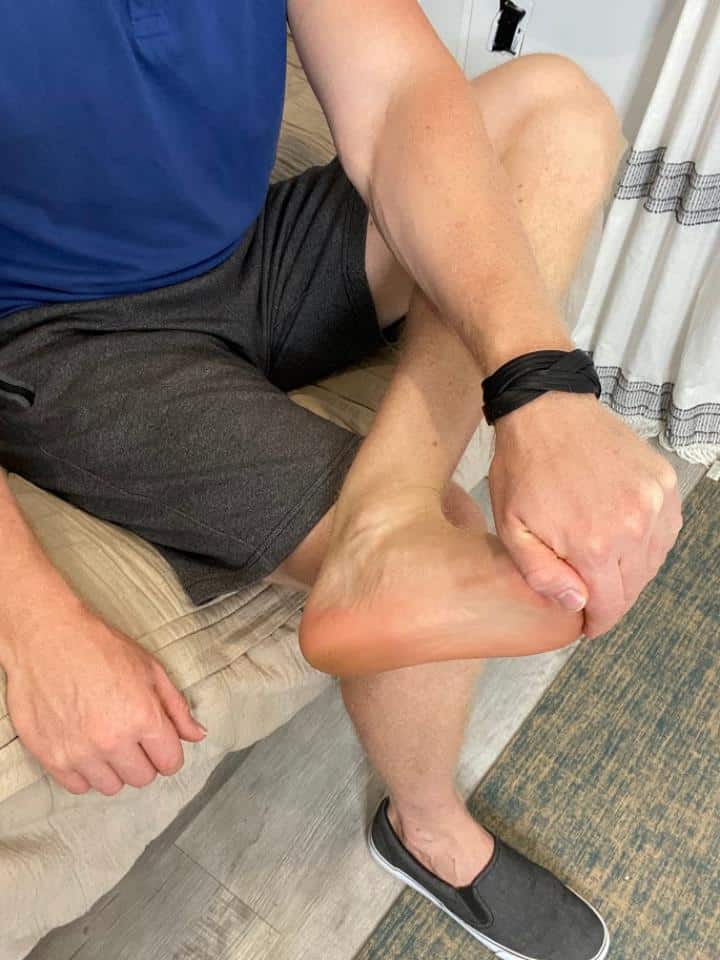
- Place one hand on the bottom of the foot, over the ball of foot.
- Gently pull the foot and ankle back into dorsiflexion, then pull slightly outward so that the foot moves away from you.
- If the stretch is very intense at first, try holding for 5 seconds, then rest. Repeat 10x.
- If the stretch is only mild, then try a longer hold time anywhere from 30-60 seconds.
This is especially a good stretch for posteromedial ankle impingement syndrome symptoms.
If it helps to see the stretches performed live, check out the video below demonstrating each stretch.
The above stretches are a gentle, easy way to address limited ankle flexibility from impingement. If, however, you’re looking for something a little more advanced, then watch the video below!
This video will demonstrate how to mobilize the ankle joint yourself at home. It’s found to be especially helpful if you’re suffering from an anterior ankle impingement syndrome, but does promote ankle dorsiflexion, which is beneficial for any posterior ankle impingement syndrome.
Four-Way Ankle Strengthening for Ankle Impingement
As you notice ankle flexibility is improving, it’s also important to strengthen the ankle, which is what this exercise grouping focuses on.
You can be seated in a chair with the working leg extended in front of you or seated upright with the leg directly in front of you while on the floor, bed or couch.
You’ll need a resistance band for these (light, medium, or heavy resistance).
1. Ankle Dorsiflexion
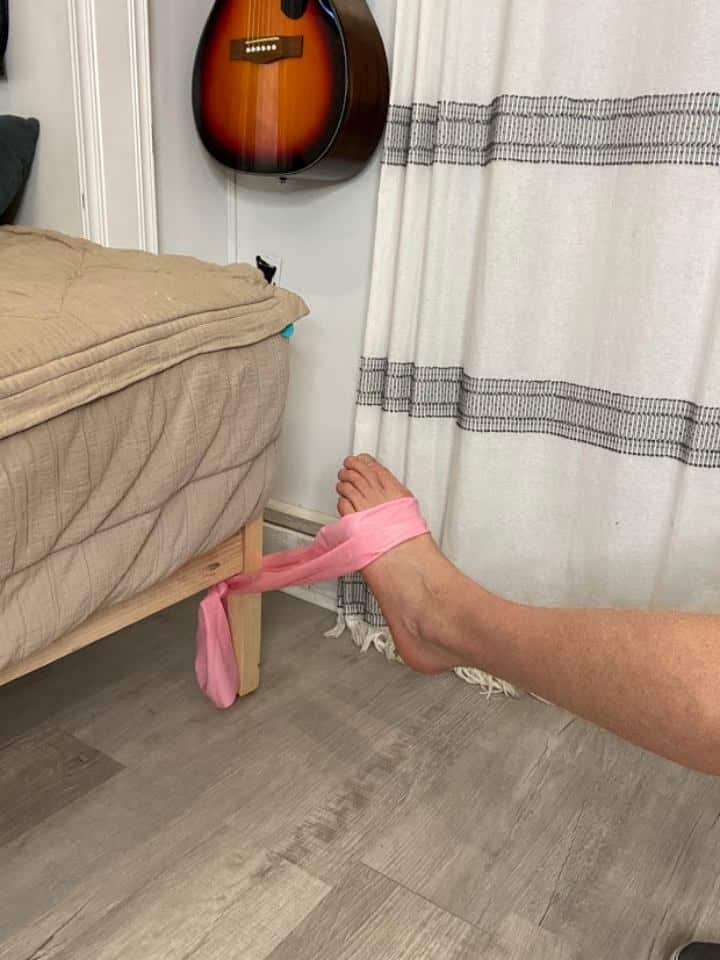
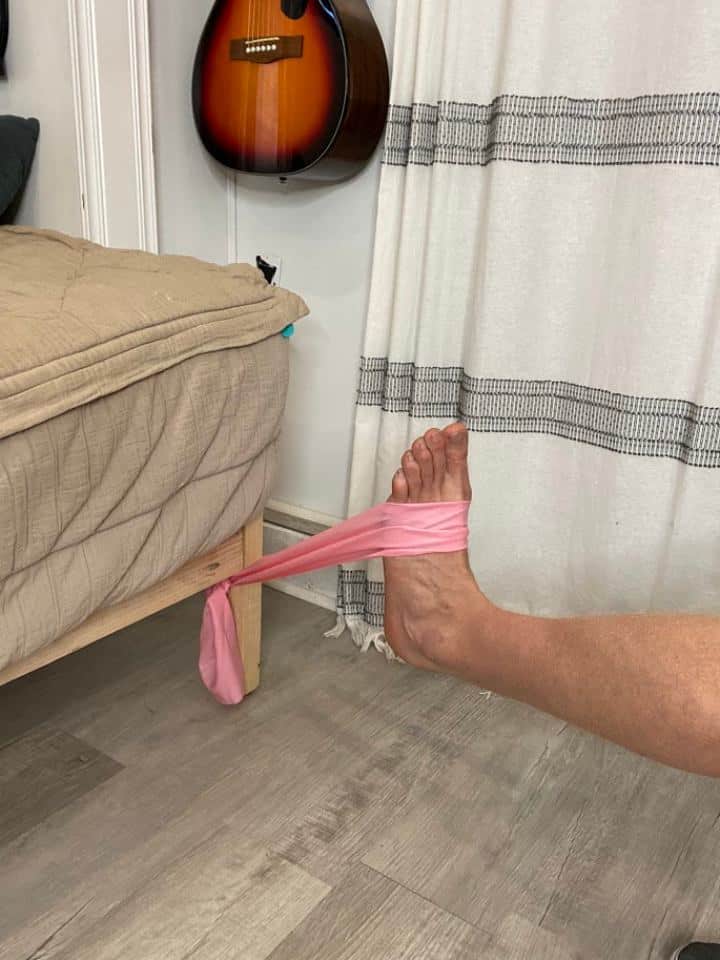
- For this one, you’ll need to either have someone hold the band for you or attach it to something secure, like a table leg.
- The band will be looped around the top of the foot at the forefoot.
- Slowly flex the ankle back as far as you can, then return to your starting position.
- Repeat 10-15 repetitions for 2-3 sets.
2. Ankle Plantar Flexion
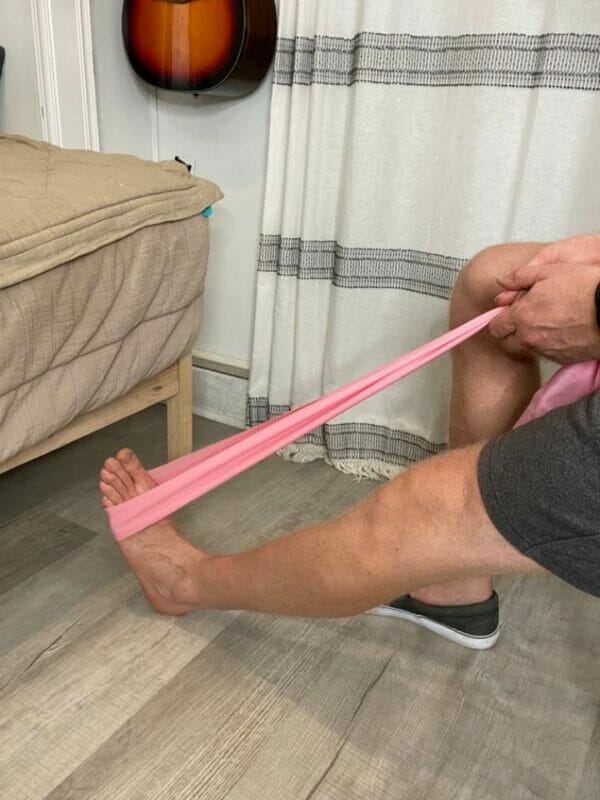
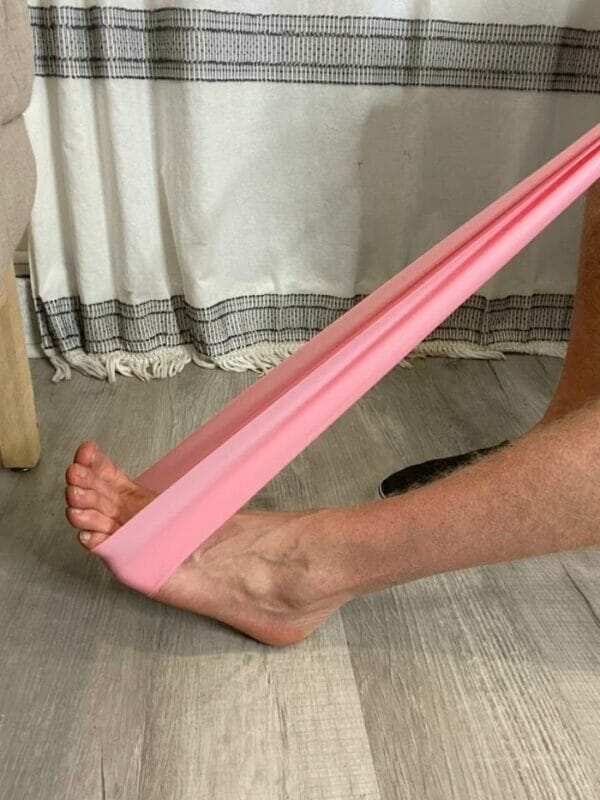
- Hold one end of the resistance band in each hand, and loop the band around the ball of foot.
- While providing band tension, slowly point the foot and ankle in a downward direction as far as you can, then return to your starting position.
- Repeat 10-15 repetitions for 2-3 sets.
3. Ankle Inversion
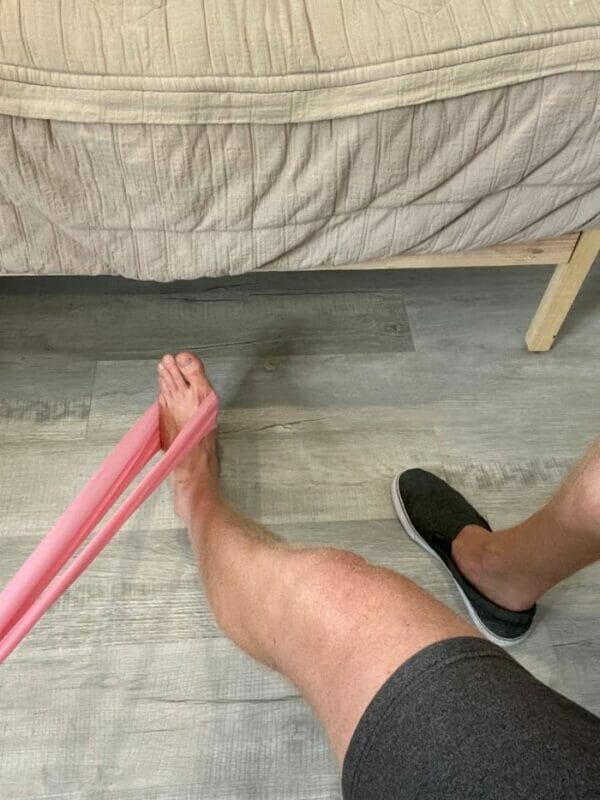
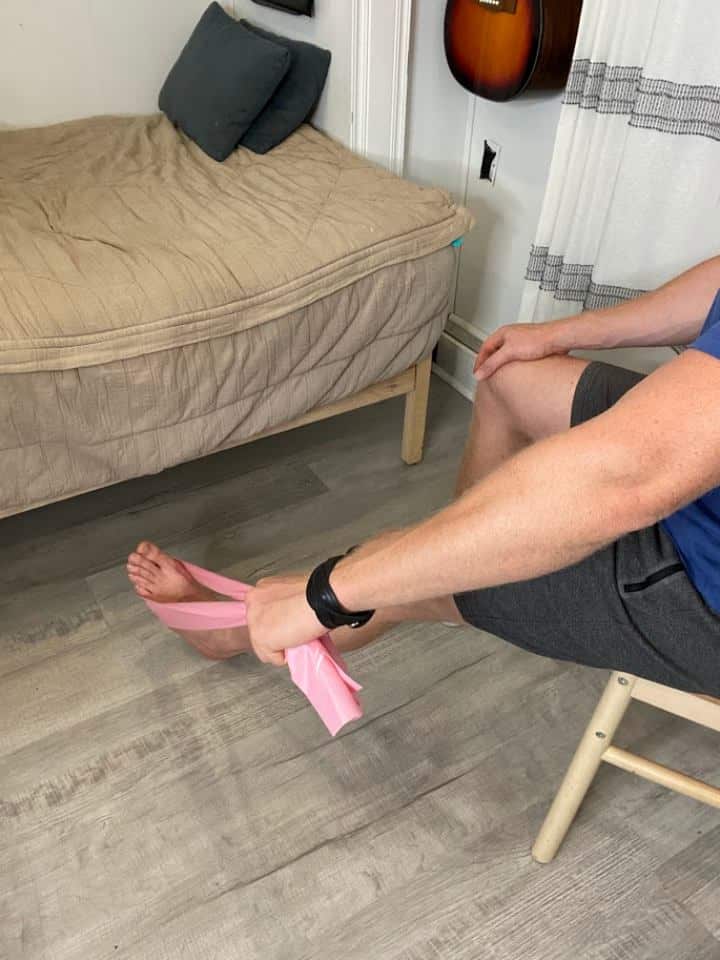
- Hold the ends of the band in the hand on the same side as the working leg, with the arm positioned out to the side.
- Slowly point the foot into plantar flexion, then scoop inward into inversion.
- Return to your starting position.
- Repeat 10-15 repetitions for 2-3 sets.
- You can also loop the band around a table leg or other secure object versus holding with the hands if that’s easier.
4. Ankle Eversion
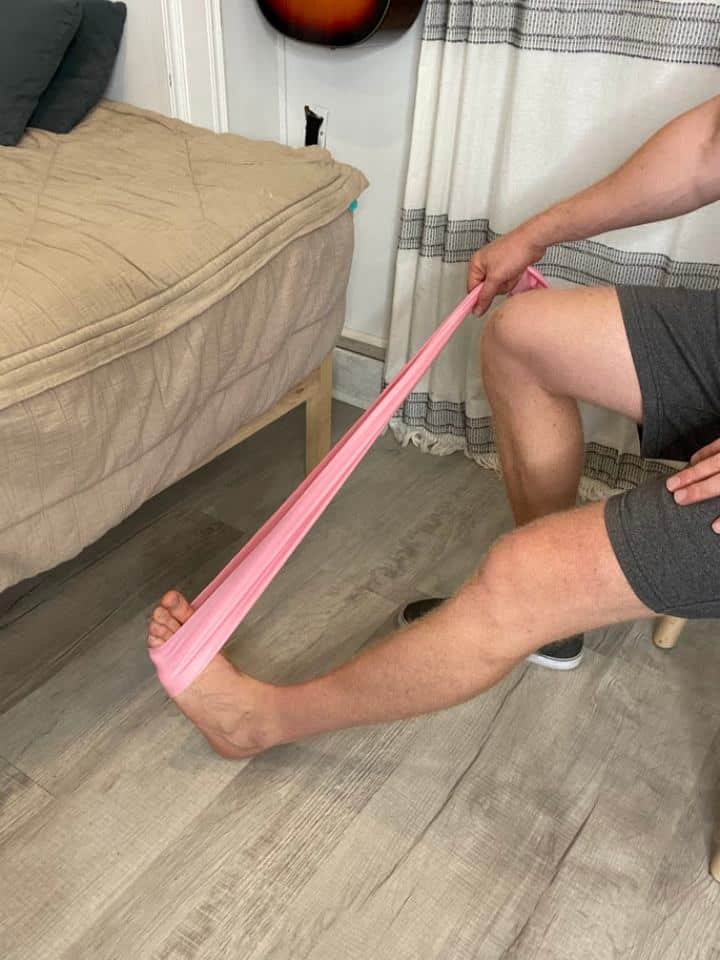
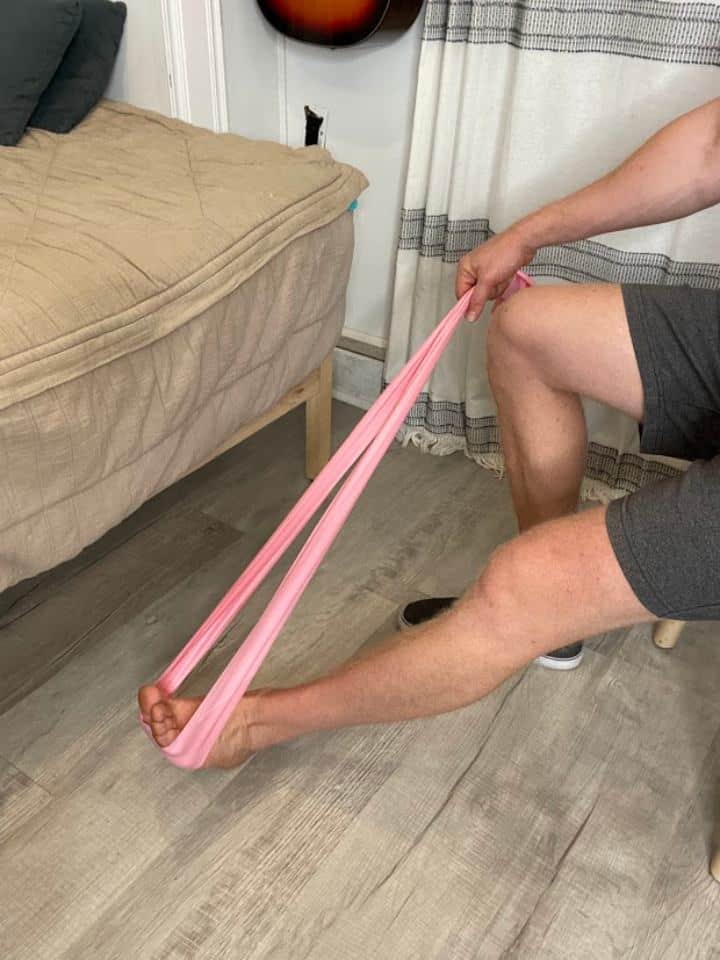
- Hold the ends of the band in the hand on the opposite side of the working leg, with the arm positioned out to the side.
- Slowly flex the ankle back into dorsiflexion, then wing the foot outward into eversion.
- Return to your starting position.
- Repeat 10-15 repetitions for 2-3 sets.
- You can also loop the band around a table leg or other secure object versus holding with the hands if that’s easier.
The video below will show a live demo of each exercise, so feel free to follow along!
Sometimes while exercising, or even walking, you may notice a popping in the ankle when ankle impingement is present. As long as this doesn’t cause pain, you should be fine to continue with your activity.
If, however, you begin experiencing pain with this popping sensation, then try to avoid whatever activity or exercise is causing this.
Additional Treatment Options for Ankle Impingement
a. Ankle Braces
When initially recovering from ankle impingement and while attempting to gradually increase your activity level, some times an ankle brace can be beneficial for additional ankle support.
This is especially true if the ankle impingement has been associated with recurrent ankle sprains and subsequent chronic ankle instability.
As your ankle impingement symptoms begin improving and you’re able to increase your activity level, you’ll want to try to gradually wean use of the ankle brace. The purpose of this is so your own soft tissues surrounding the ankle joint will re-learn how to support the joint independently without relying on any external devices for assistance.
b. Shoe Wear
The right shoe wear for impingement of the ankle is very important.
If your foot or ankle naturally demonstrates any structural deviations that place you at a higher risk for developing impingement of the ankle, having the right shoe wear is vital to avoid this.
An example of this is a flat foot. If you naturally have more collapsed arches, resulting in a flat foot, then your shoes need to provide the right amount of arch support to help correct this as much as possible.
Sometimes additional shoe inserts will be needed as well.
If you participate in a sporting or other recreational activity, particularly one with high impact movements such as running, then wearing the proper shoe wear will help support the foot and ankle, as well as reduce your risk of injury.
By reducing your risk of injury, this will lessen your chance of developing ankle impingement syndrome.
c. Steroid Injections
There are times with impingement of the ankle that you may be experiencing a large amount of inflammation in the ankle joint. When this occurs, it can contribute to pain, swelling, tightness and weakness.
While inflammation is a natural part of healing, if it continues uncontrolled, this can affect your recovery.
In cases of stubborn inflammation that is causing higher pain levels, a steroid injection may be needed.
While this is not something that should become a regularly needed treatment, it can help with initial break-through pain so that you can move your recovery along more quickly and tolerably.
d. Surgery
There are instances when surgical treatment may be necessary for impingement of the ankle. This is usually the case if conservative measures, such as physical therapy, have failed to relieve symptoms.
The exact surgical treatment and procedure necessary will vary between individuals and each particular case and type of ankle impingement syndrome.
A common procedure for releasing impingement of the ankle is an ankle arthroscopy.
Arthroscopic surgery aims to release and remove whatever structures are causing the impingement of the ankle, whether this be a soft tissue impingement or a structural impingement, such as bone spurs or osteophytes.
If a soft tissue injury is the cause of the impingement, such as a tendon rupture or tear, then surgical treatment of this injury may be the key to solve the problem. If during this type of surgery, the surgeon notices any other joint structures contributing to the impingement, then they will likely remove and clean those out as well.
Recovery From Surgery for Ankle Impingement
While surgical recovery very much depends on the exact procedure performed, when considering a standard ankle arthroscopy, the recovery is overall fairly timely.
Some may require use of assistive devices, such as crutches, or an immobilizer for a few weeks post-operatively.
Once cleared by your surgeon, you’ll begin physical therapy. The rehab process may take a few months for you to regain full use of the ankle and return to your previous activities.
Living with Ankle Impingement

It’s important to remember that while you’re having your ankle joint impingement treated, stay as active as you can!
Just make sure to avoid any activity that might further aggravate your symptoms.
If you can go for a walk, bike ride, or any other type of exercise without causing more ankle pain, then go for it!
FAQ:
Who can I see about ankle impingement?
You can consult with your primary care physician, a podiatrist, an orthopedist who specializes in foot and ankle injuries, physical therapist or a chiropractor.
Should I ice my ankle if it has impingement?
Sure! Ice is a great tool to help with pain and swelling. You can ice the ankle for up to 20 minutes at a time. Make sure to take at least a 30-minute break between icing sessions.
What are the best shoes for ankle impingement?
This really depends on your particular type of impingement syndrome and the structural alignment of your foot and ankle. Your healthcare provider should be able to make a specific recommendation after evaluating you. You could also visit a specialized shoe store who can fit you for the right shoe. The most important thing is that the shoe provides the best support and alignment for the foot and ankle.












